


Aluth Avurudu Celebration (Sinhala & Tamil New Year)
The Sinhala and Tamil New Year is a date of great importance in the Island’s calendar.
Sinhala & Tamil New Year, generally known as Aluth Avurudda (Aluth Avurudhu” in Sinhala and “Puththandu in Tamil) in Sri Lanka, is the new year of the Sinhalese and Tamil people in Sri Lanka. The Sri Lankan Sinhalese and Tamil New Year is a national festival which has been celebrated for centuries. The most pronounced areas of the New Year festivities are food, games and the rituals of goodwill.
According to Sinhalese astrology, New Year begins when the sun moves from Meena Rashiya (the house of Pisces) to Mesha Rashiya (the house of Aries). It also marks the end of the harvest and spring.
The custom of offering betel to parents and elders symbolises the act of paying gratitude. The children in turn receive blessings from parents. The sense of goodwill and friendship among relations and friends is also seen during the festival time.
The new year games can be categorised as indoor and outdoor games. Some of the indoor games are bello (sea shells) and kaju (cashew nuts). The outdoor games are havari hengima (hiding the wig), chaggudu and kotta pora (pillow-fighting), kathuru oncilla , ankeliya , olinda keliya, eluvan keliya, mevara sellama, raban upatha, buhu keliya, muthi gesilla, rena dela del, muthu keliya, onchili varam and mee sellama.
Celebrated by most Sri Lankan one form or another, the Sinhala and Tamil New Year involves the young and the old, and goodwill that strengthens friendships, community ties and has even produced many entertainment activities.
For the Sinhalese, Aluth Avurudda begins with families improving their homes – thoroughly cleaning, even perhaps painting. A few days before the festival, traditional food items are prepared in lieu of the celebrations.
Tamil customs are a little different. Before the rituals begin, the entrance of the house is purified with saffron water. Intricate designs called kolam, made of rice flour – a neat drawing of colourful curved loops, drawn around a pattern of dots – decorate the floor.
On the ultimate day of the old year or Parana Avurudda, the Sinhalese take a herbal bath, prior to which the head is anointed with predetermined auspicious oils. This year the juice of Kohomba (neem) leaves will be applied on the head by a senior Buddhist priest at the temple – or, if at home, an elderly relative – with blessings for health and longevity. Rituals are a harbinger of good luck.
We wish the Founder & Spiritual Advisor of the Maha Karuna Buddhist Society, Chief Reverend B. Sri Saranankara Maha Thera and those who celebrates Aluth Avurudda.
Happy Sinhala New Year ! Su∙bȧ a∙luth auw∙rudh∙dhak vḗ∙wa!
Aluth Avurudu庆祝活动(僧伽罗和泰米尔新年)
僧伽罗和泰米尔新年是该岛日历中极为重要的日期。
僧伽罗语和泰米尔语的新年,通常被称为斯里兰卡的僧伽罗语中的Aluth Avurudda(Aluth Avurudhu)和泰米尔语的“ Puththandu”,是斯里兰卡僧伽罗人和泰米尔人的新年。斯里兰卡的僧伽罗语和泰米尔语新年是一个全国性的节日,已有数百年的历史。新年庆祝活动中最显着的方面是食物,游戏和善意仪式。
根据僧伽罗人占星术,新年是从太阳从双鱼座的米娜·拉希亚(Meena Rashiya)到白羊座的玛莎·拉希亚(Mesha Rashiya)移开的。这也标志着收成和春天的结束。
向父母和长者提供槟榔的习俗象征着感恩之情。孩子们反之得到父母的祝福。在节日期间,也可以看到亲戚之间的善意和友谊。新年游戏可以分为室内和室外游戏。一些室内游戏是贝乐(贝壳)和kaju(腰果)。户外游戏是havari hengima(隐藏假发),chaggudu和kotta pora(打枕头子),kathuru oncilla,ankeliya,olinda keliya,eluvan keliya,mevara sellama,raban upatha,buhu keliya,muthi gesilla,rena dela del,muthu keliya,onchili varam和mee sellama。
对于僧伽罗人来说,Aluth Avurudda首先是家庭改善住房环境-彻底清洁大扫除,甚至画画。节日前几天,准备了传统食品来代替庆祝活动。
泰米尔人的习俗有所不同。在仪式开始之前,房子的入口要用藏红花水净化。由米粉制成的错综复杂的设计称为kolam,是点缀点状图案的彩色弯曲环的整洁图,用于装饰地板。
在元旦或帕拉那·阿弗鲁达(Parana Avurudda)的最后一天,僧伽罗人会洗一次草药,然后在头上涂上预定的吉祥油。
Kohomba(印em)叶汁将由寺院的一位资深僧侣或(如果在家中是一位年长的亲戚)在头上涂抹,并为健康和长寿加持。仪式预示着好运。
我们祝愿宏慈佛教会的创始人兼精神顾问,尊者斯里里沙拉南长老以及庆祝Aluth Avurudda的人们。
新年快乐! Su∙bȧa∙luth auw∙rudh∙dhakvḗ∙wa!

